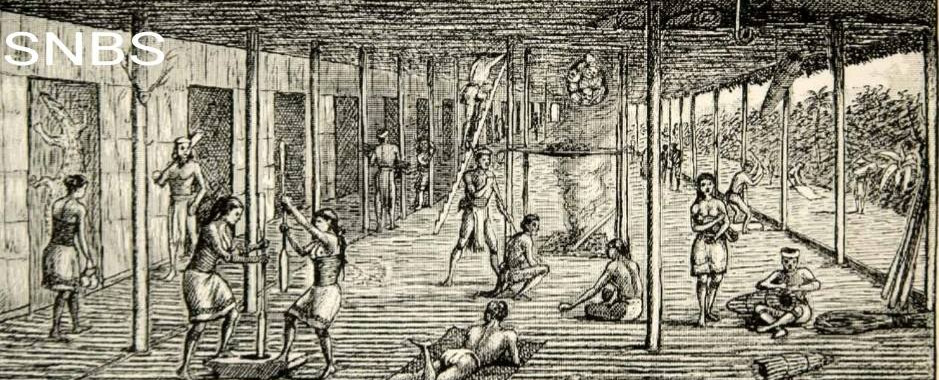EARLY HISTORY OF INANAM: THE TOBILUNG KADAZANDUSUN TRIBE, YEAR 1735
- Marwan Bin Musa
- Feb 26
- 4 min read
The history of the Tobilung Tribe, a branch of the Mononggigi Tribe, is said to have begun with a great and courageous warrior named Gumuron. Gumuron was believed to have originated from China and later migrated to Brunei.
Gumuron’s son, a renowned warrior named Galampas, led his people from Brunei to Nunuk Ragang. Galampas’ son, Somporou, was born in Nunuk Ragang. One day, Somporou’s son, Woyoon Aki Guminggon, decided to leave Nunuk Ragang and migrate to Inanam with his sons, Tombolung and Lakou.
Tombolung had four sons and one daughter. His daughter, the eldest, was married and pregnant when Tombolung decided to migrate to Pindasan with his brother Lakou and his sons, Lajou, Bujang, Gimadang, and Saganggoh. Due to her pregnancy, Tombolung’s daughter was left behind in Inanam under the care of her grandfather, Guminggon. Before departing, Tombolung left instructions for his father and daughter to search for them once she had given birth. He also left bamboo poles along the path, referred to as "kukurungan," "pogontoluon," "gigimpuan," or "tingkahang," to mark the way.
Tombolung stayed in Pindasan for three years. When his wife passed away, he decided to move to Nuluu Rumun, or "Rumun Hill," now known as Kampung Dudar. He made this decision after witnessing an eagle flying and dancing before perching on a large branch. This story of the eagle also became the inspiration for the "Mongigal" dance.
Tombolung lived to the age of 100 before passing away. After his death, Lajou and Saganggoh moved along the Lintupan River and established a settlement called Lapai, now known as Mengaris. Gimadang and Bujang moved to Kampung Sarang. Lakou, Tombolung’s brother, a mighty and strong warrior, migrated to Tinongkuban and took up farming. He remained vigilant and would immediately come to the aid of his kin in Mengaris and Sarang if they were attacked by enemies. Upon his passing, Lakou was buried in Timbang.
To this day, some claim that the Tobilung Tribe derives its name from the great warrior Tombolung, while others believe it comes from the Tobilung tree. Before the arrival of the British Chartered Company, there were over 200 Tobilung people living in Ulu Kukut. At one point, a cholera outbreak struck the village, resulting in many deaths, and the deceased were buried in Ulu Kukut. The survivors were forced to relocate to Mengaris and Langkon, with a few remaining in Ulu Kukut.
When the Tobilung Tribe migrated to Kota Marudu, they were forced to engage in warfare against the Momogun Tribe. The Tobilung people from Mengaris, Lobak Sungai, and Tampinatau often united in battles against the Momogun Tribe. They also fought against the Kogosingan and Lotud Tribes during the era of tribal wars and headhunting (known as "misangod rondom"), which was a part of their way of life in the past. The Tobilung people of Kota Marudu assert that the Tobilung Tribe was the first Kadazandusun tribe to settle in Inanam.
After leaving Nunuk Ragang, two great Tobilung warriors, Mondowoi and Memburing, migrated to Tambunan via the Kogibangan River, crossing the Trus Madi range, and following the Pagalan River, where they established Tobilung settlements. The Tobilung were among the earliest settlers and a major Kadazandusun tribe in Tambunan. During conflicts between the Tuhawon and Tibabar Tribes, the Tobilung Tribe was often called upon as a trusted and respected mediator to resolve disputes.
The Tobilung Tribe also migrated along the Tandulu River from the Crocker Range, establishing several villages in Inobong, Penampang, and Inanam. Due to frequent migrations and wars before and after Nunuk Ragang, the Tobilung Tribe eventually split into three main regions: Tambunan, Inanam, and Kota Marudu. Returning to the story of Tombolung’s daughter and her grandfather Guminggon in Inanam, they were unable to bring their ancestral jars when they migrated northward. Instead, they established several villages from Inanam to Kionsom.
The Tobilung Tribe also founded settlements in Kitobu, Dambai, Tobilung, and Tatahan. When the Tobilung people first arrived in Inanam, they inhabited an area of 20 acres stretching from the Inanam River to Kampung Sinulihan Baru. Inanam, Menggatal, and Api-Api were ceded to the British Chartered Company in 1898. Prior to that, Inanam served as the main stronghold of the legendary warrior Paduka Mat Salleh. The Tobilung Tribe played a significant role in the early resistance of Sabah’s indigenous communities, joining forces with Mat Salleh in the fight against British colonial forces.
When the British Chartered Company attacked Inanam and the Tobilung villages in 1897, they discovered many looted items from Pulau Gaya in Tobilung homes. The Tobilung also allied with the Tagahas Tribe to raid the market in Pogunan, Tambunan, turning the Inanam market into a major trading hub for local agricultural and livestock products on the west coast at the time.
Compiled by: Kumis Kumis
Illustration: HH Everett
References: (Dalrymple 1767), (Forrest 1779), (Hutton 1883), (Dalrymple 1883), (Daly 1886), (Roth 1896), (Evan 1922), (Rutter 1922), (BNBH 16.1.1932), (Santaren 1956), (Wood Moser 1958), (Caroll 1960), (Robert Nicholls 1960), (Harrison 1958, 1962, 1971), (Beurdeley 1974), (Sonza 1979), (Kaim Karimin 1981), (James Ongkili 1983), (Smith 1984), (Bellwood 1985), (Phelan 1997), (Timis Sambadi 1998), (PS Shim 2000, 2003, 2007)

















Comments